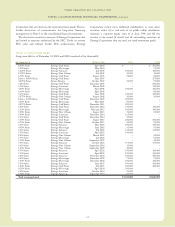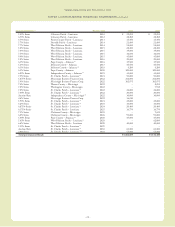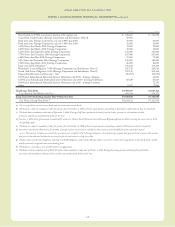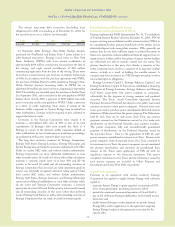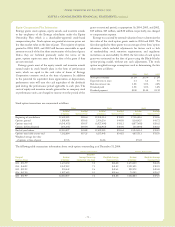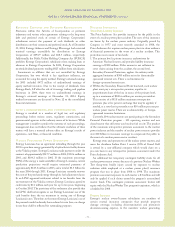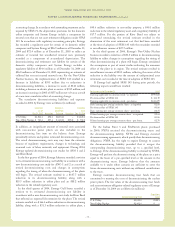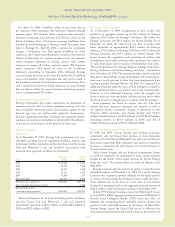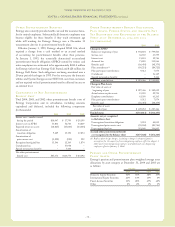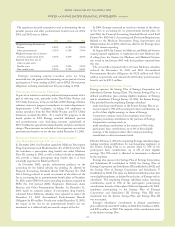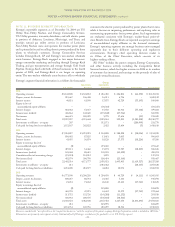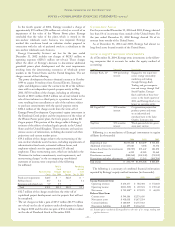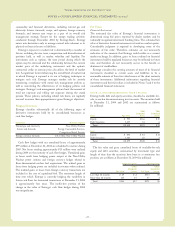Entergy 2004 Annual Report Download - page 78
Download and view the complete annual report
Please find page 78 of the 2004 Entergy annual report below. You can navigate through the pages in the report by either clicking on the pages listed below, or by using the keyword search tool below to find specific information within the annual report.
-76 -
Entergy Corporation and Subsidiaries 2004
NOTES to CONSOLIDATED FINANCIAL STATEMENTS continued
The Energy Policy Act of 1992 contains a provision that
assesses domestic nuclear utilities with fees for the decontamination
and decommissioning (D&D) of the DOE’s past uranium
enrichment operations. Annual assessments in 2004 were
$4.4 million for Entergy Arkansas, $1.1 million for Entergy Gulf
States, $1.6 million for Entergy Louisiana, and $1.8 million for
System Energy. The Energy Policy Act calls for cessation of
annual D&D assessments not later than October 24, 2007. At
December 31, 2004, two years of assessments were remaining.
D&D fees are included in other current liabilities and other
non-current liabilities and, as of December 31, 2004, recorded
liabilities were $8.8 million for Entergy Arkansas, $1.9 million for
Entergy Gulf States, $3.3 million for Entergy Louisiana, and
$3.3 million for System Energy. Regulatory assets in the financial
statements offset these liabilities, with the exception of Entergy
Gulf States’ 30% non-regulated portion. These assessments are
recovered through rates in the same manner as fuel costs.
Income Taxes
Entergy is currently under audit by the Internal Revenue Service
(IRS) with respect to tax returns for tax periods subsequent to 1995
and through 2001, and is subject to audit by the IRSand other
taxing authorities for subsequent tax periods. The amount and
timing of anytax assessments resulting fromthese audits are
uncertain, and could have a material effect on Entergy’s financial
position and results of operations. Entergy believes that the
contingency provisions established in its financial statements will
sufficiently cover the risk associated with tax matters. Certain
material audit matters as to which management believes there is a
reasonable possibility of a future tax assessment are discussed below.
See Note 3 to the consolidated financial statements for additional
discussion of income taxes.
Foreign Tax Credits
In July 1997, the UK government enacted the Windfall Tax, which
was a one-time tax imposed on formerlygovernment-owned
companies in regulated industries. The Windfall Tax applied to
companies that the government had previously privatized in the
telecommunication, airport operation, gas, water, electricity, and
railway industries. London Electricity, the UK public limited
companypurchased and subsequently sold by Entergy, was subject
to the UK Windfall Tax. Entergy fulfilled its obligation with respect
to the tax in 1997 and 1998. In subsequent tax years, Entergy
reported a foreign tax credit for the UK Windfall Tax that London
Electricity paid. Entergy has claimed a net tax benefit of $152 mil-
lion related to this foreign tax credit.
During 2004, the IRS proposed to disallow this foreign tax
credit. Entergy disagreed with the position of the IRS and
protested the disallowance of the credit to the Office of IRS
Appeals. Entergyexpects to receive a Notice of Deficiency in 2005
for this item, and plans to vigorously contest this matter. The
amount at issue including tax and interest as of December 31, 2004
is $195 million. Entergy believes that the contingency provision
established in its financial statements will sufficiently cover the risk
associated with this dispute.
Depreciable Property Lives
During the years 1997 through 2004, Entergy subsidiaries,
Entergy Services, Entergy Arkansas, Entergy Gulf States, Entergy
Louisiana, Entergy Mississippi, Entergy New Orleans, and System
Energy Resources reflected changes in tax depreciation methods
with respect to certain types of depreciable property (e.g. street
lighting, billing meters, and various generation plant equipment).
The cumulative effect of these changes results in additional
depreciation deductions generating a cash flow benefit of
approximately $152 million as of December 31, 2004. The related
IRS interest exposure if the deduction is ultimately disallowed is
$44 million at December 31, 2004. This benefit reverses over time
and will also fluctuate with each year’s addition to those types
of assets. Due to the temporary nature of the tax benefit, the
potential interest charge represents the total net earnings exposure
of Entergy.
For the years under audit, 1996-2001, the IRS challenged
Entergy’s classification of these assets and proposed adjustments to
the depreciation deductions taken. Entergy disagrees with the
position of the IRS and has protested the disallowance of these
deductions to the Office of IRS Appeals. Entergy expects to
receive a Notice of Deficiencyin 2005 for this item, and plans
to vigorously contest this matter. Entergy believes that the
contingency provisionestablished in its financial statements
sufficientlycovers the risk associated with this item.
Mark to Market of Certain Power Contracts
In 2001, Entergy Louisiana changed its method of accounting for
tax purposes related to its wholesale electric power contracts. The
most significant of these is the contract to purchase power from the
Vidalia hydroelectric project. The new tax accounting method
has provided a cumulative cash flow benefit of approximately
$790 millionas of December 31, 2004. The related IRS interest
exposureis $93 million at December 31, 2004. This benefit
is expected to reverse in the years 2005 through 2031. The election
did not reduce bookincome tax expense. The timing of
the reversal of this benefit depends on several variables, including
the price of power. Due to the temporary nature of the tax
benefit, the potential interest charge represents Entergy’s net
earnings exposure. Entergy Louisiana’s 2001 tax return is currently
under examinationby the IRS, though no adjustments have yet
been proposed with respect to the mark to market election. Entergy
believes that the contingency provision established in its financial
statements will sufficiently cover the risk associated with this issue.
CashPoint Bankruptcy
In 2003, the domestic utility companies entered an agreement with
CashPoint Network Services (CashPoint) under which CashPoint
was to manage a network of payment agents through which
Entergy’sutility customers could pay their bills. The payment agent
system allows customers to pay their bills at various commercial
or governmental locations, rather than sending payments by
mail. Approximately one-third of Entergy’s utility customers use
payment agents.



